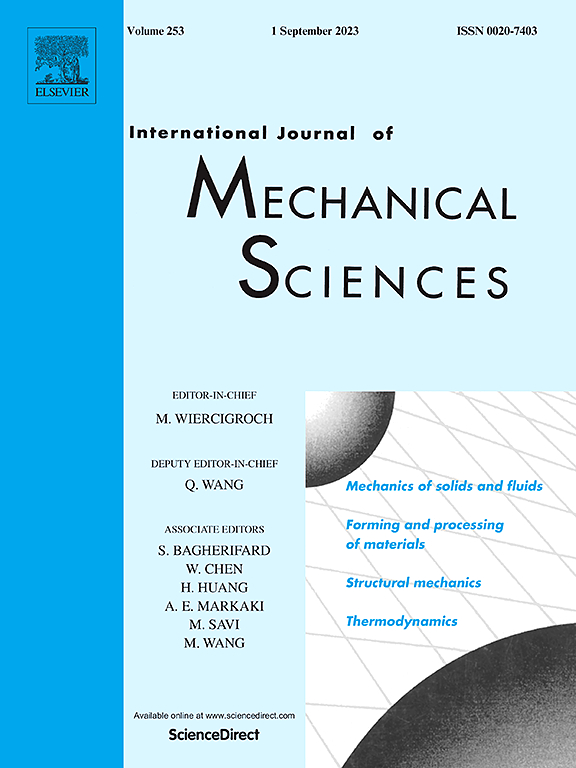Microstructure-sensitive low-cycle fatigue in a nickel-base single crystal superalloy: Constitutive modeling and life assessment
IF 7.1
1区 工程技术
Q1 ENGINEERING, MECHANICAL
International Journal of Mechanical Sciences
Pub Date : 2025-04-17
DOI:10.1016/j.ijmecsci.2025.110235
引用次数: 0
Abstract
Mechanical properties of nickel-base single crystal superalloys undergo degradation during service due to microstructural changes like coarsening and rafting. The low-cycle fatigue performance along [001] crystal orientation in the coarsened and rafted DD6 alloys was studied by experiments and theoretical analysis. Fatigue tests across various microstructure states with different strain ratios at elevated temperatures revealed substantial life reduction. A novel tensorial representation for microstructure was proposed and demonstrated unique advantages over conventionally used scalar parameters. For the first time, the effects of coarsening and rafting were decoupled through the independent components of fabric tensors of -matrix and -precipitate phases. A microstructure-sensitive crystal plasticity-based constitutive model and a fatigue life prediction model were developed for mechanical behaviors along [001] crystal orientation using fabric tensors. The stress drop and life reduction in the coarsened and rafted alloys were well modeled. Both the accuracy and conservativeness of the life prediction results were significantly improved. The applications of fabric tensors in constitutive modeling and fatigue assessment show the potential to offer enhanced insights and predictive capabilities, enabling more comprehensive evaluations of structural integrity in various operational conditions and environments.

镍基单晶高温合金的显微组织敏感低周疲劳:本构建模和寿命评估
镍基单晶高温合金在使用过程中会发生粗化、泛化等微观组织变化,导致其力学性能下降。通过实验和理论分析,研究了粗化后的DD6合金沿[001]晶向的低周疲劳性能。高温下不同应变比下不同微观结构状态下的疲劳试验表明,寿命显著降低。提出了一种新的微观结构张量表示方法,与传统的标量参数相比具有独特的优势。通过γ-基体和γ′相的织张量的独立分量,首次解耦了粗化和筏化的影响。基于织物张量,建立了基于显微结构敏感晶体塑性的本构模型和疲劳寿命预测模型,用于分析[001]晶体取向的力学行为。模拟了粗化和筏化合金的应力下降和寿命降低。寿命预测结果的准确性和保守性均有显著提高。织物张量在本构建模和疲劳评估中的应用表明,它具有增强洞察力和预测能力的潜力,能够在各种操作条件和环境下对结构完整性进行更全面的评估。
本文章由计算机程序翻译,如有差异,请以英文原文为准。
求助全文
约1分钟内获得全文
求助全文
来源期刊

International Journal of Mechanical Sciences
工程技术-工程:机械
CiteScore
12.80
自引率
17.80%
发文量
769
审稿时长
19 days
期刊介绍:
The International Journal of Mechanical Sciences (IJMS) serves as a global platform for the publication and dissemination of original research that contributes to a deeper scientific understanding of the fundamental disciplines within mechanical, civil, and material engineering.
The primary focus of IJMS is to showcase innovative and ground-breaking work that utilizes analytical and computational modeling techniques, such as Finite Element Method (FEM), Boundary Element Method (BEM), and mesh-free methods, among others. These modeling methods are applied to diverse fields including rigid-body mechanics (e.g., dynamics, vibration, stability), structural mechanics, metal forming, advanced materials (e.g., metals, composites, cellular, smart) behavior and applications, impact mechanics, strain localization, and other nonlinear effects (e.g., large deflections, plasticity, fracture).
Additionally, IJMS covers the realms of fluid mechanics (both external and internal flows), tribology, thermodynamics, and materials processing. These subjects collectively form the core of the journal's content.
In summary, IJMS provides a prestigious platform for researchers to present their original contributions, shedding light on analytical and computational modeling methods in various areas of mechanical engineering, as well as exploring the behavior and application of advanced materials, fluid mechanics, thermodynamics, and materials processing.
 求助内容:
求助内容: 应助结果提醒方式:
应助结果提醒方式:


